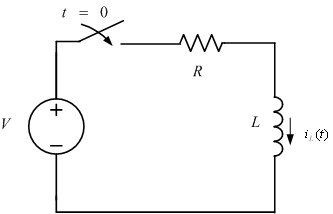RL Circuits: Difference between revisions
| Line 20: | Line 20: | ||
<math>i(0) = 0</math> | <math>i(0) = 0</math> | ||
Now applying Kirchoff's Voltage Law (loop-rule) we obtain the equation: | Now applying Kirchoff's Voltage Law (loop-rule) we obtain the first order differential equation: | ||
<math>V = iR + L\frac{di}{dt}</math> | <math>V = iR + L\frac{di}{dt}</math> | ||
Now we solve the equation. Rearranging: | |||
<math>\frac{di}{dt} = \frac{V-iR}{L}</math> | <math>\frac{di}{dt} = \frac{V-iR}{L}</math> | ||
<math>/frac{di}{V-iR} = /frac{dt}{L}</math> | |||
Integrating both sides: | |||
<math>-/frac{</math> | |||
===A Computational Model=== | ===A Computational Model=== | ||
Revision as of 01:43, 12 April 2016
RL Circuits CLAIMED BY VJ SERVERA
The Main Idea
An RL circuit is one that contains resistors and inductors. The simplest type of these circuits involves one resistor and one inductor, and is called a first order RL circuit. The order of the circuit is equal to the number of inductors involved in the circuit. In this section we will study the following circuit:
A Mathematical Model
First we must remember the relationship between current going through an inductor and the voltage drop across it. The relationship is simply
[math]\displaystyle{ {L\frac{d\vec{i}}{dt}} = \vec{v(t)} }[/math]
meaning that the derivative of the current going through the inductor is proportional to the voltage drop across it. The proportionality constant is the inductance [math]\displaystyle{ L }[/math].
Before the switch closes, we know there is no current going through the inductor , and therefore no voltage. The initial conditions are:
[math]\displaystyle{ v(0) = 0 }[/math]
[math]\displaystyle{ i(0) = 0 }[/math]
Now applying Kirchoff's Voltage Law (loop-rule) we obtain the first order differential equation:
[math]\displaystyle{ V = iR + L\frac{di}{dt} }[/math]
Now we solve the equation. Rearranging:
[math]\displaystyle{ \frac{di}{dt} = \frac{V-iR}{L} }[/math]
[math]\displaystyle{ /frac{di}{V-iR} = /frac{dt}{L} }[/math]
Integrating both sides:
[math]\displaystyle{ -/frac{ }[/math]
A Computational Model
How do we visualize or predict using this topic. Consider embedding some vpython code here Teach hands-on with GlowScript
Examples
Be sure to show all steps in your solution and include diagrams whenever possible
Simple
Middling
Difficult
Connectedness
- How is this topic connected to something that you are interested in?
- How is it connected to your major?
- Is there an interesting industrial application?
History
Put this idea in historical context. Give the reader the Who, What, When, Where, and Why.
See also
Are there related topics or categories in this wiki resource for the curious reader to explore? How does this topic fit into that context?
Further reading
Books, Articles or other print media on this topic
External links
Internet resources on this topic
References
This section contains the the references you used while writing this page
